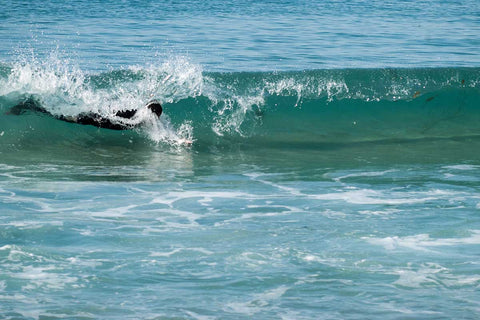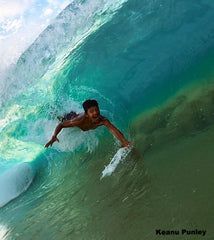What is Bodysurfing?
Shop our full line of bodysurfing gear!
Excerpt from the Encyclopedia of Surfing:
 Nothing factual is known about the origins of bodysurfing, but it's possible that humans were inspired to emulate wave-riding sea animals such as dolphins and seals. Bodysurfing certainly predates board-surfing, which itself, University of Hawaii anthropologist Ben Finney suggests, may date as far back as 2000 B.C. Recorded bodysurfing history, however, begins after that of board-surfing. In 1899, Australian Fred Williams was taught to bodysurf by Tommy Tanna, a Polynesian islander brought to Sydney to work as a gardener; Williams in turn taught local "surf-bathers" how to ride waves.
Nothing factual is known about the origins of bodysurfing, but it's possible that humans were inspired to emulate wave-riding sea animals such as dolphins and seals. Bodysurfing certainly predates board-surfing, which itself, University of Hawaii anthropologist Ben Finney suggests, may date as far back as 2000 B.C. Recorded bodysurfing history, however, begins after that of board-surfing. In 1899, Australian Fred Williams was taught to bodysurf by Tommy Tanna, a Polynesian islander brought to Sydney to work as a gardener; Williams in turn taught local "surf-bathers" how to ride waves.
Riding a wave using only the body as a planing surface; the original and purest form of surfing. Prior to the invention of the surf leash in the early 1970s, all surfers were adept bodysurfers, as nearly every wipeout was followed by a bodysurfing ride to the beach to pick up the lost board. In the 1990s, bodysurfing was being described as "the lost art," but in the new century, following along with the sport's neo-retro movement, it had a significant uptick in popularity. "It's just so complimentary to what the wave is doing," bodysurfing ace Mike Stewart said in 2009. "To me it's the best interaction between man and nature that exists."
Read the rest here at the Encyclopedia of Surfing
From inertia.com:
When I tell people that I bodysurf, most immediately identify “bodysurfing” with a middle-aged, overweight father who launches himself in front of a wave while joyfully laughing with his eight-year-old daughter at the beach. They don’t understand what it truly means to bodysurf a real wave. I describe to these people (mostly friends from the mainland) what it’s like to paddle out into the heavy surf at pipeline when it’s double overhead and the rip just pulls you over towards the lifeguard stand (which is 100 yards away) in a matter of seconds. I tell them how hollow the barrels are at Waimea as I drop into them, how you could easily fit two buses stacked on top of each other inside of the barrel. I try to explain what it’s like to duck dive a 20ft wave at Pipe while trying not to panic, which is nearly impossible. I illustrate with my arms that you see this mountain of a wave coming towards you and you see the lineup hauling ass to get over it before it breaks – you better swim as fast as you can before it lands on you. Most of the time, I will swim to the bottom and hold onto the reef so I won’t get sucked up and shredded to pieces while the massive mountain of a wave roars above my head. A good bodysurfer will jump on the opportunity to catch the wave and ride it as far as he can before the face will eventually catch up to you and swallow you up. This is bodysurfing…
I tell them how hollow the barrels are at Waimea as I drop into them, how you could easily fit two buses stacked on top of each other inside of the barrel. I try to explain what it’s like to duck dive a 20ft wave at Pipe while trying not to panic, which is nearly impossible. I illustrate with my arms that you see this mountain of a wave coming towards you and you see the lineup hauling ass to get over it before it breaks – you better swim as fast as you can before it lands on you. Most of the time, I will swim to the bottom and hold onto the reef so I won’t get sucked up and shredded to pieces while the massive mountain of a wave roars above my head. A good bodysurfer will jump on the opportunity to catch the wave and ride it as far as he can before the face will eventually catch up to you and swallow you up. This is bodysurfing…
Read the rest of the Inertia article here
|
|
By: Todd Partridge •
 Someone somewhere along the way had an idea that the drag inherent in bodysurfing could be reduced by holding a little piece of wood in one's hand. And boy were they right. Called a handplane or handboard these little suckers really do work. Using the principle of hydrodynamic lift, handplanes at speed work in the same manner as does a racing boat -the faster it moves the more of the boat is out of the water, reducing drag and allowing even greater speed.
Someone somewhere along the way had an idea that the drag inherent in bodysurfing could be reduced by holding a little piece of wood in one's hand. And boy were they right. Called a handplane or handboard these little suckers really do work. Using the principle of hydrodynamic lift, handplanes at speed work in the same manner as does a racing boat -the faster it moves the more of the boat is out of the water, reducing drag and allowing even greater speed.
It’s an undeniable fact that using a handplane gives you more lift, speed and control over just using your body giving you better positioning so you can stay higher, travel further and make sections you normally wouldn’t make. Using a hand board makes a big difference in riding small mushy waves. Hand boarding is the best half hour of fun you can have in the ocean.





Todd Partridge
Author